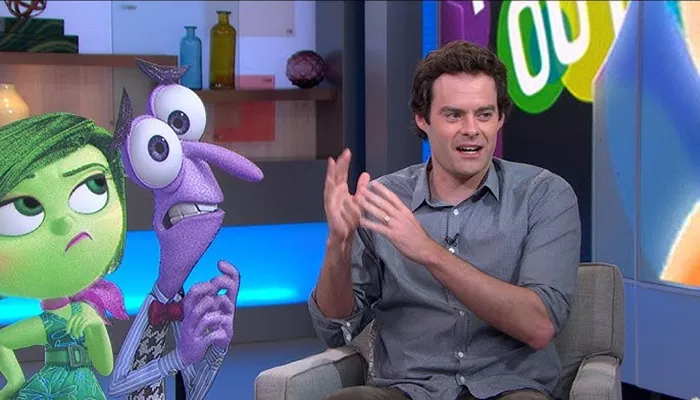Pixar’s Inside Out 2 has officially returned to theaters, rekindling the imaginative world inside a young girl’s mind. While fans were eager to see the original emotions return, many noticed one major absence—Bill Hader, the voice behind Fear in the original film, is missing from the sequel. This surprising change left viewers wondering: Why is Bill Hader not in Inside Out 2?
Hader’s portrayal of Fear was both comical and nuanced, making him a fan-favorite. However, he does not reprise his role in the sequel, prompting widespread curiosity. In this article, we’ll break down the real reasons behind his absence, how the film industry influenced the situation.
Bill Hader’s Role in the First Inside Out
When the original Inside Out premiered in 2015, it was met with critical and commercial acclaim. Bill Hader voiced Fear, one of the five main emotions inside Riley’s mind. His performance provided a perfect balance of anxiety, humor, and charm. Hader brought a unique rhythm and nervous energy that resonated with both kids and adults.
Alongside other star talents like Amy Poehler (Joy), Mindy Kaling (Disgust), and Phyllis Smith (Sadness), Hader contributed to what became one of Pixar’s most emotionally intelligent films. Many fans expected the entire cast to return for the sequel. Unfortunately, that didn’t happen.
Why Fear Mattered
Fear’s character served a key role in Riley’s emotional development. He represented caution and awareness of danger—both critical in adolescence. As Riley matures in the sequel, Fear’s presence is still necessary, which is why the character remains in the film, albeit voiced by a different actor.
The Real Reason: Contract and Pay Disputes
The primary reason Bill Hader is not in Inside Out 2 boils down to salary negotiations. According to reports, both Hader and Mindy Kaling were offered lower compensation for returning compared to other cast members. Pixar allegedly proposed the same flat fee to returning actors, regardless of their profile or previous roles in the film’s success.
Hader declined to return, citing concerns over fairness and undervaluation. Mindy Kaling also opted out for similar reasons. The studio ultimately recast Fear and Disgust with different voice actors. This decision reflects broader issues in the film industry regarding voice talent recognition and equitable pay.
Who Voices Fear Now?
In Inside Out 2, the character of Fear is now voiced by Tony Hale, known for his role in Arrested Development and Veep. While Hale brings his own flair to the role, long-time fans of Hader’s interpretation might notice a shift in tone and delivery. Pixar aimed to maintain continuity while giving new actors room to make the roles their own.
The Bigger Picture: Pay Equity in Animation
Bill Hader’s departure from Inside Out 2 is not just an isolated case. It sheds light on the broader issue of pay equity in animation, particularly among voice actors. Despite their significant contributions, voice actors are often paid far less than live-action performers of similar fame.
This disparity is especially evident in high-grossing animated films. For instance, Inside Out grossed over $850 million worldwide, yet reports suggest the main cast did not receive compensation reflecting the movie’s success. The disconnect between profit and pay continues to stir debate in Hollywood.
Industry Reactions
Many in the industry have supported Hader’s stance. His refusal to return over pay concerns was seen by some as a stand for fair treatment of voice actors. Others worry it sets a precedent for major studios to recast roles easily, minimizing the perceived value of the original voice cast.
The Storyline of Inside Out 2: What Changed?
Inside Out 2 explores Riley’s emotional life as she enters her teenage years. The sequel introduces new emotions like Anxiety, Envy, and Embarrassment, adding complexity to her inner world. These additions shift the focus from the original core group of emotions, though Fear, Anger, and Sadness still play key roles.
This shift in focus might have contributed to Pixar’s decision to reallocate resources, including voice talent. As the story grows more layered, the new characters are given more screen time and emotional weight, changing the dynamic from the first movie.
How the Plot Evolves
Set in a new phase of Riley’s life, Inside Out 2 blends classic Pixar charm with more nuanced storytelling. Although Fear is still present, he is not the central emotional anchor. This reduced role might also have factored into Hader’s decision to walk away, feeling that the role’s scope no longer justified the negotiation process.
Audience Reaction to the Cast Change
Audience reactions have been mixed. Some fans felt disappointed not hearing Hader’s familiar voice, while others praised Tony Hale’s performance. The general consensus, however, is that while Hale did a commendable job, the original cast chemistry is hard to replicate.
Fan Discussions and Reviews
Social media and forums have been abuzz with speculation and debate. Some fans support Pixar’s decision to recast, believing it keeps the story fresh. Others lament the absence of original cast members like Hader and Kaling, citing a break in continuity.
Conclusion
Bill Hader’s absence from Inside Out 2 stems from deeper issues than scheduling or story relevance. It’s a reminder of ongoing industry conversations around pay equity and respect for voice talent. While the new voice cast does a strong job, many fans will still miss the charm and depth Hader brought to Fear.
In the end, Inside Out 2 is still a vibrant and emotionally rich film, but it’s also a case study in how behind-the-scenes decisions can shape the emotional tone of a story—sometimes in ways viewers can instantly feel.

